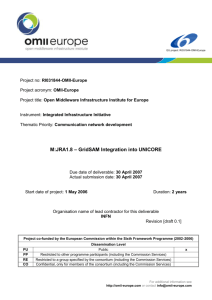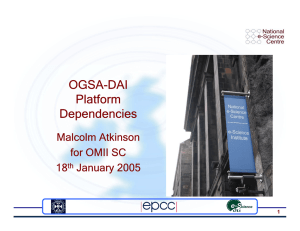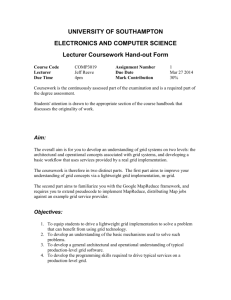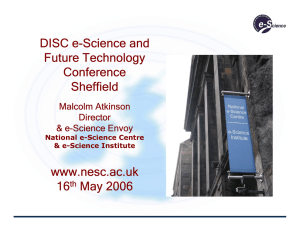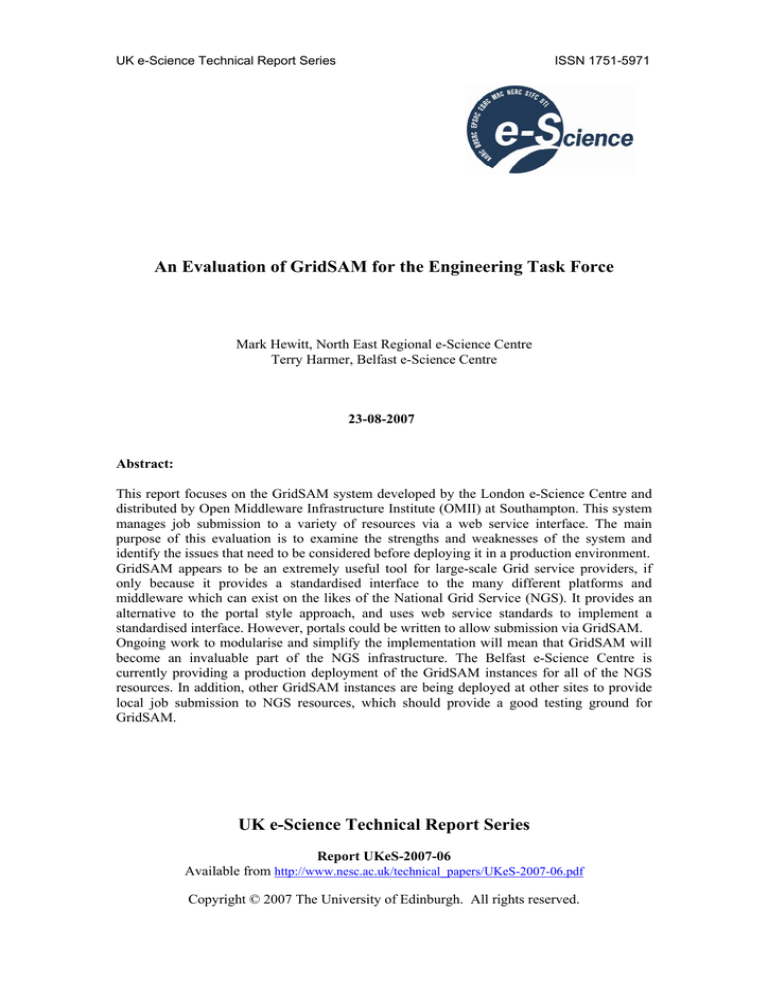
UK e-Science Technical Report Series
ISSN 1751-5971
An Evaluation of GridSAM for the Engineering Task Force
Mark Hewitt, North East Regional e-Science Centre
Terry Harmer, Belfast e-Science Centre
23-08-2007
Abstract:
This report focuses on the GridSAM system developed by the London e-Science Centre and
distributed by Open Middleware Infrastructure Institute (OMII) at Southampton. This system
manages job submission to a variety of resources via a web service interface. The main
purpose of this evaluation is to examine the strengths and weaknesses of the system and
identify the issues that need to be considered before deploying it in a production environment.
GridSAM appears to be an extremely useful tool for large-scale Grid service providers, if
only because it provides a standardised interface to the many different platforms and
middleware which can exist on the likes of the National Grid Service (NGS). It provides an
alternative to the portal style approach, and uses web service standards to implement a
standardised interface. However, portals could be written to allow submission via GridSAM.
Ongoing work to modularise and simplify the implementation will mean that GridSAM will
become an invaluable part of the NGS infrastructure. The Belfast e-Science Centre is
currently providing a production deployment of the GridSAM instances for all of the NGS
resources. In addition, other GridSAM instances are being deployed at other sites to provide
local job submission to NGS resources, which should provide a good testing ground for
GridSAM.
UK e-Science Technical Report Series
Report UKeS-2007-06
Available from http://www.nesc.ac.uk/technical_papers/UKeS-2007-06.pdf
Copyright © 2007 The University of Edinburgh. All rights reserved.
1
INTRODUCTION................................................................................................2
2
GENERAL INFORMATION .............................................................................2
2.1
2.2
2.3
2.4
3
SYSTEMS MANAGEMENT..............................................................................3
3.1
3.2
3.3
3.4
3.5
3.6
3.7
3.8
4
DOCUMENTATION FOR SYSTEM MANAGERS ...................................................3
SERVER DEPLOYMENT ....................................................................................3
CLIENT DEPLOYMENT .....................................................................................3
ACCOUNT MANAGEMENT ...............................................................................4
RELIABILITY ...................................................................................................4
DISTRIBUTED MANAGEMENT ..........................................................................4
EXTERNAL SERVICES ......................................................................................4
SCALABILITY ..................................................................................................4
USER EXPERIENCE..........................................................................................4
4.1
4.2
4.3
4.4
4.5
4.6
4.7
5
PROVIDER .......................................................................................................2
LICENSING ......................................................................................................2
SUPPORTED PLATFORMS .................................................................................2
SUPPORT .........................................................................................................3
DOCUMENTATION FOR USERS .........................................................................4
JOINING THE GRID...........................................................................................5
LEGACY APPLICATION INTEGRATION .............................................................5
MIGRATION BETWEEN PLATFORMS .................................................................5
USABILITY ......................................................................................................5
SECURITY FROM THE USER’S PERSPECTIVE ....................................................5
VERIFICATION .................................................................................................5
DEVELOPER EXPERIENCE ...........................................................................5
5.1
5.2
5.3
DOCUMENTATION FOR DEVELOPERS...............................................................5
LANGUAGES AND TOOL SUPPORT ...................................................................6
HOW EASY IS TO DEVELOP NEW SERVICES THAT EXPAND THE GRID’S CORE
FUNCTIONALITY? ........................................................................................................6
6
TECHNICAL .......................................................................................................6
6.1
6.2
6.3
6.4
6.5
7
BELFAST E-SCIENCE NGS GRIDSAM DEPLOYMENTS .........................6
7.1
8
ARCHITECTURE ...............................................................................................6
STANDARDS & SPECIFICATIONS ......................................................................6
SECURITY........................................................................................................6
INDUSTRIAL SUPPORT .....................................................................................6
CAPABILITY & FUNCTIONALITY .....................................................................6
MULTIPLE GRIDSAM INSTANCES IN A CONTAINER. .......................................7
CONCLUSIONS ..................................................................................................9
APPENDIX I ..............................................................................................................10
2
1
Introduction
The UK’s Engineering Task Force (ETF) is evaluating several Grid middleware solutions in
order to take a view on their readiness for deployment on the resources within the National
Grid Service (NGS) and those of the wider UK e-Science community. This report focuses on
the GridSAM system developed by the London e-Science Centre and distributed by Open
Middleware Infrastructure Institute (OMII) at Southampton. This system manages job
submission to a variety of resources via a web service interface.
The main purpose of this evaluation is to examine the strengths and weaknesses of the system
and identify the issues that need to be considered before deploying it in a production
environment.
2
General Information
The GridSAM system is intended both as an add-on for the OMII suite of middleware as well
as a standalone system. GridSAM enables compute jobs to be submitted to a connected
compute resource using standardised web service interface. The compute job is defined by a
job description that conforms to the JSDL job description language standard.
GridSAM allows jobs to be submitted to various resources such as OMII, Globus and Condor.
GridSAM’s role is to provide a standardised client interface for job submission and data file
management.
Its actions are along similar lines to GRAM from the Globus project; however it makes
exclusive use of web services technologies.
2.1
Provider
The software is developed by the London e-Science Centre (LeSC) and is distributed as part
of the OMII managed programme.
2.2
Licensing
All software produced by OMII (rather than simply repackaged) is produced under a modified
BSD licence which allows distribution of the source code and binary forms of the software.
(For the text of the modified licence, see Appendix I)
2.3
Supported platforms
The server can run on any Linux platform and the client is currently available for both
Windows and Linux. As GridSAM uses a web service interface it should be possible for any
architecture to communicate with a GridSAM server deployment. Both machines were used
for both client and server. OMII and Condor were running on the same machine at Newcastle,
GT4 was running on the same machine at Belfast.
Newcastle Configuration
1 x 1GHz single processor with 1GB RAM.
Belfast Configuration
32 x 2 GHz SunFire Blade System with 1 GB RAM.
GridSAM version 1.1 was installed at both sites. There have been further releases since the
evaluation took place but these are not considered in this document.
3
2.4
Support
GridSAM is available free of charge from OMII. There is currently no commercial support of
the package, although support is available from the developers at OMII. However from
experience this is limited to the developers only but available to any type of user, be that
administrator, installer or user.
3
3.1
Systems Management
Documentation for System Managers
Installation documentation was somewhat fragmented. Full installation requires the user to
first install the full OMII stack, and here the documentation is of a good quality and takes you
step by step through the process. The GridSAM installation guide is a small part of this
documentation, and while it provides sufficient detail to install a GridSAM service the
documentation is not extensive.
Some of the commands, such as those required to start and stop the system, referred to an
older version of the OMII software.
The installations were carried out using binaries downloaded from the OMII website.
Installation from source is possible, but was not attempted in this evaluation. The OMII
software itself requires SUSE 9.0, so this was the OS used to avoid any potential
compatibility issues.
3.2
Server Deployment
GridSAM was installed at Newcastle together with an OMII stack install, hence it required
the same environment as the OMII software itself. The recommended platform was SuSE 9.0,
which was used in Newcastle.
The developers had already anticipated Newcastle’s problems with port 8080, whereby no
application can access this port on campus due to their web-cache policy, so the software runs
on port 18080 by default.
The installation process is relatively straightforward when GridSAM is installed at the same
time as the OMII stack. However it is rather less simple when a standalone installation is
being attempted. There is a general lack of indication as to when the server is running and
when it is not.
At BeSC, GridSAM instances were deployed that managed job submission to NGS resources
at Leeds, Oxford and Manchester, and other resources at Cardiff, Cambridge and Glasgow.
These were hosted under RedHat ES. As above, the installation process was relatively
straightforward, and once one service was deployed new services could easily be added. The
services were deployed into the OMII container and directly into Tomcat without significant
problems.
3.3
Client Deployment
There are two GridSAM clients with the distribution, one for Linux and one for Windows.
They both consist of applications which will communicate with the GridSAM server via its
web service endpoint. There are various tools for submitting jobs and tracking their progress.
It is not necessary to use the client applications, as these simply provide a more user-friendly
way of submitting requests to the GridSAM server.
4
3.4
Account Management
The job submission required a user certificate in the client. A user’s certificate is
communicated to the resource being used and enables access control and accounting to be
applied at the resource. No accounting control was applied within the hosted GridSAM
instance. However, it may be possible to generate such information from the GridSAM or
OMII log files themselves.
3.5
Reliability
The software has not been tested under high loads or failure conditions. However, the
deployed instances at BeSC have been field deployed for several months and have been used
for a significant number of job submissions without a problem. They have not required any
maintenance in their deployment and have not crashed in that period.
3.6
Distributed management
There appears to be little backwards compatibility between versions, as the interface for the
recently released GridSAM 2 is different from the GridSAM 1 version we tested. GridSAM is
not intended to be deployed on every machine in a Grid, but rather to serve as a gateway
through which users can submit jobs to a standardised interface which are then passed on to
the middleware stack running at the local institution.
OMII are supporting the GridSAM system as part of their ‘managed programme’, which
means updated versions of GridSAM are distributed with releases of the OMII software itself,
as well as being available separately.
3.7
External Services
GridSAM is designed to use a standardised web services interface so, theoretically any
external system is capable of submitting a job to the GridSAM instance.
Internally, GridSAM is built in a modular structure with separate DRM connectors which
allow GridSAM to communicate to a local job submission system. It is possible to write a
new DRMConnector for any new middleware system.
3.8
Scalability
We found during our evaluations that a single GridSAM instance is not particularly scaleable
when dealing with a heterogeneous environment. Each instance will listen on one port and
then take incoming jobs and direct them to one job management system, whether that be
OMII, Condor or just using Fork. There is no inbuilt mechanism to either allow a user to
specify where the job should be run, or for the system itself to be able to pick between
different resources. The GridSAM team have said that this may well be implemented in later
versions of the software.
The solution we had to employ to resolve this problem was to deploy several instances of
GridSAM, with different endpoints, each of which would submit jobs to different resources
and different institutions. However this is clearly not a scaleable solution.
4
4.1
User Experience
Documentation for Users
GridSAM is not intended for end users, and the mechanisms of submission are designed to be
hidden behind client software. The documentation is sufficient to install and manage the
instances.
5
4.2
Joining the Grid
Since GridSAM merely provides an interface to an already established grid system, then each
system will have its own requirements for joining. However GridSAM can simplify this
process by its inbuilt security and certificate mechanisms. GridSAM can of course be
configured to only run types of jobs specified by the user, e.g. only jobs from their own VO
(Virtual Organisation)
4.3
Legacy Application Integration
GridSAM is designed to submit to any system as long as a DRMConnector can be written for
it. Alternative jobs can be run singly using ‘fork’, however this is not a scaleable solution.
4.4
Migration between platforms
GridSAM is designed to use standardised interfaces for communicating with clients.
Integrating it with different middleware applications is somewhat less straightforward, but by
no means impossible.
4.5
Usability
This is one area where GridSAM is not as easy as it could be. This is mostly due to the
limitations of supporting applications such as Tomcat. Difficulties were experienced in
determining the status of the GridSAM server. End users at the client side should not see
GridSAM in action, as it should be hidden by a client application: writers of the client
applications should see using GridSAM as being just like submitting to any JSDL compliant
job execution service.
4.6
Security from the User’s Perspective
GridSAM can be deployed to communicate using HTTP and HTTPS. In both cases, however,
a user’s certificate must be installed in the client application to enable authentication of the
user at the resource being used. The issues affecting GridSAM are the issues affecting all
deployed web services.
OMII clients require the user to have a certificate and private key in a java keystore, and the
password to this stored in a text file. At present this is not permitted under the UK e-Science
CA policy, therefore if GridSAM together with OMII were to be deployed on the NGS
production service this is something which would need to be looked at very closely.
4.7
Verification
The standard GridSAM client includes a job monitoring tool which will report the status of
the job and any errors which occur.
5
5.1
Developer Experience
Documentation for Developers
In attempting to develop an additional component for GridSAM, there is very little (if any)
documentation to allow this. All support had to come from the developers.
However, good support is provided by the developers of GridSAM. Newcastle especially
received extensive information on the GridSAM architecture, which at the time of writing
was not available to the public.
6
5.2
Languages and Tool Support
GridSAM in its OMII deployment is supplied with a job submission client. However, a
deployed GridSAM instance can be used directly using an appropriate (WS-Security enabled)
web service call.
How easy is to develop new services that expand the Grid’s core
5.3
functionality?
It is possible to extend GridSAM to allow it to submit to different middleware applications,
but again this is a non-trivial task given the lack of documentation.
6
Technical
GridSAM is packaged as part of an OMII installation and thus relies on OMII for its
installation and support. However, BeSC deployed GridSAM within an off-the-shelf Tomcat
installation with no problems.
6.1
Architecture
Job submission is a basic resource capability for a grid environment, and a building block for
an SOA (Service Oriented Architecture). GridSAM’s functionality may be regarded as a basic
job submission capability only. There is a need for GridSAM to manage and broker job
submission to multiple resources.
6.2
Standards & Specifications
GridSAM implements version 1.0 of JSDL, the web services standard for the submission of
jobs.
6.3
Security
The requirement for a client to communicate a user’s certificate is a necessary step in usage
access and accounting control
6.4
Industrial Support
No industrial support for GridSAM could be identified.
6.5
Capability & Functionality
Job submission is a basic capability that is needed to support usage and management of
networked resources. GridSAM provides this basic capabilities and its capabilities (or ones
like them) will be needed by NGS and other compute providers. However, the current system
is a first step only and it will be required to provide support for multiple resources and the
brokering of submission between resources.
7
Belfast e-Science NGS GridSAM Deployments
Belfast e-Science (BeSC) deployed, in Spring 2007, a collection of GridSAM services to
provide an interface to the NGS resources. The GridSAM services were hosted in Belfast but
provided job submission services to resources in Bristol, Cardiff, Lancaster, Leeds,
Manchester, Oxford, RAL and Westminster.
The BeSC hosting environment consists of some 60 servers split across sites in London
Docklands, Tadworth and three sites in Belfast. The servers are primarily used as a hosting
environment for grid/web services. The preferred hosting environment with the BeSC
infrastructure is services hosted within a virtual machine (VM).
Most of the infrastructure within BeSC is 64-bit—this posed an initial problem in that OMII
64-bit deployments were available for Enterprise Edition Operating systems that were not
7
used with BeSC. However, a 32-bit hosting VM containing OMII services was created to
contain GridSAM instances.
Below is the sequence of steps followed in BeSC to deploy GridSAM for NGS Resources
using GridSAM 2.0.0 using OMII 3.2.0 with Tomcat 5.0.25.
1. Creating a GridSAM Virtual Machine.
A single GridSAM instance VM was constructed and proved reliable in test deployment.
OS: SuSe 10.1. RAM: 512 Mbytes VM Size: 1 Gbyte.
2. Creating a Multiple Instance GridSAM Virtual Machine.
The single GridSAM VM was deployed with second service 1 . In initial tests both services
proved reliable. However, the Java VM quickly ran out of memory and GridSAM
crashed. Further testing of the single instance VM demonstrated that its JVM size would
increase steadily and eventually crash with a memory error also. 2
OS: SuSe 10.1. RAM: 512 Mbytes VM Size: 1 Gbyte. Java VM size: 512 Mbytes
3. Creating a host OS GridSAM
The VM approach provides a neat and easily managed solution to deployment. However,
it was clear that it would not work for a large number of GridSAM instances. Thus, a 64bit machine was converted to run a 32-bit OS to provide a hosting environment for
GridSAM.
In this OS a collection of GridSAM instances were deployed in a single OMII/Tomcat
container. The environment provided a stable environment for running up to 4 GridSAM
instances which ran approximately 2 weeks and crashed with a JVM out-of-memory
error. This 4-instance behaviour was predicable in several weeks of testing. With more
than four instances the JVM would crash within 4 hours for 5 instances and 5 minutes for
8 instances.
OS: SuSe 10.1. RAM: 4 Gbytes. VM Size: 1 Gbyte
4. The Final Configuration.
Given the experience outlined above, the final BeSC deployment for NGS resources
consisted of 2 Tomcat containers serving two ports with each containing 4 GridSAM
instances. As described above, these operate without problem for approximately 2 weeks
without problem but will then crash with out-memory-problems. To prevent this, the
hosting server is automatically rebooted once a week in a scheduled 15 minute
maintenance period.
OS: SuSe 10.1. RAM: 4 Gbyte. VM Size: 1 Gbyte
7.1
Multiple GridSAM Instances in a Container.
The standard OMII container must be configured carefully to permit multiple GridSAM
instances to run correctly.
1. move the files listed below from
../OMII/jakarta-tomcat-5.0.25/webapps/gridsam/WEB-INF/lib to
../OMII/jakarta-tomcat-5.0.25/shared/lib
bc*.jar
1
See later for instructions on deploying multiple instances.
BeSC believe there is a memory leak with GridSAM or its supporting libraries, but have no
conclusive proof of this.
2
8
cryptix*.jar
puretls*.jar
2. make a copy of the
../OMII/jakarta-tomcat-5.0.25/webapps/gridsam/
folder e.g.
../OMII/jakarta-tomcat-5.0.25/webapps/gridsam2/
3. modify the following files to configure the new service:
…./gridsam2/WEB-INF/classes/jobmanager.xml
or which ever configuration file your jobmanager.xml points to configure the
remote job manager. (This is outlined in the OMII GridSAM instructions.)
…/gridsam2/WEB-INF/classes/database.xml
to configure database for GridSAM. (This is outlined in the OMII GridSAM
instructions.)
…gridsam2/WEB-INF/classes/config/wse/service.properties
to set the service path. (This is outlined in the OMII GridSAM instructions.)
…gridsam2/WEB-INF/classes/config/wse/services.properties
to set the service path. (This is outlined in the OMII GridSAM instructions.)
4. Restart tomcat. (not OMII)
9
8
Conclusions
GridSAM appears to be an extremely useful tool for large-scale Grid service providers, if
only because it provides a standardised interface to the many different platforms and
middleware which can exist on the likes of the National Grid Service (NGS).
GridSAM provides an alternative to the portal style approach and uses web service standards
to implement a standardised interface. However, portals could be written to allow submission
via GridSAM.
Ongoing work to modularise and simply the implementation will mean that GridSAM will
become an invaluable part of the NGS infrastructure.
BeSC is currently providing a production deployment of the GridSAM instances for all of the
NGS resources. In addition, other GridSAM instances are being deployed at other sites to
provide local job submission to NGS resources which should provide a good testing ground
for GridSAM.
10
Appendix I
The OMII (Open Middleware Infrastructure Institute) distribution comprises
open source software from different sources with different licences. All of
the software developed by OMII is provided under the Modified BSD licence as
given below. Licences for all other software may be found in the top level
'licenses' directory. Copyright (C) 2004-6, OMII, University of Southampton.
All rights reserved. Redistribution and use in source and binary forms, with
or without modification, are permitted provided that the following
conditions are met: Redistributions of source code must retain the above
copyright notice, this list of conditions and the following disclaimer.
Redistributions in binary form must reproduce the above copyright notice,
this list of conditions and the following disclaimer in the documentation
and/or other materials provided with the distribution. Neither the name of
the OMII, University of Southampton nor the names of its contributors may be
used to endorse or promote products derived from this software without
specific prior written permission. THIS SOFTWARE IS PROVIDED BY THE
COPYRIGHT HOLDERS AND CONTRIBUTORS "AS IS" AND ANY EXPRESS OR IMPLIED
WARRANTIES, INCLUDING, BUT NOT LIMITED TO, THE IMPLIED WARRANTIES OF
MERCHANTABILITY AND FITNESS FOR A PARTICULAR PURPOSE ARE DISCLAIMED. IN NO
EVENT SHALL THE COPYRIGHT OWNER OR CONTRIBUTORS BE LIABLE FOR ANY DIRECT,
INDIRECT, INCIDENTAL, SPECIAL, EXEMPLARY, OR CONSEQUENTIAL DAMAGES
(INCLUDING, BUT NOT LIMITED TO, PROCUREMENT OF SUBSTITUTE GOODS OR SERVICES;
LOSS OF USE, DATA, OR PROFITS; OR BUSINESS INTERRUPTION) HOWEVER CAUSED AND
ON ANY THEORY OF LIABILITY, WHETHER IN CONTRACT, STRICT LIABILITY, OR TORT
(INCLUDING NEGLIGENCE OR OTHERWISE) ARISING IN ANY WAY OUT OF THE USE OF
THIS SOFTWARE, EVEN IF ADVISED OF THE POSSIBILITY OF SUCH DAMAGE.
11

